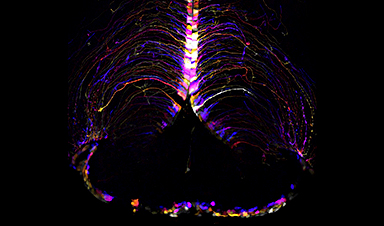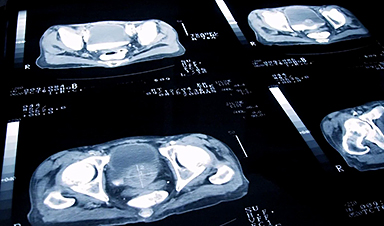A new study led by Massachusetts General Hospital (MGH) investigators finds that radiation therapy may increase the uptake of therapeutic nanoparticles by glioblastomas, raising the possibility of using both growth-factor-targeted and immune-system-based therapies against the deadly brain tumor. The team describes how pretreatment with low-dose radiation increased delivery to tumors of nanoparticles carrying small interfering RNA (siRNA) molecules and significantly improved survival in a mouse model of glioblastoma.
“We found that radiation therapy primes brain tumors for enhanced uptake of nanotherapeutics, allowing us to develop a targeted nanoparticle to deliver siRNAs for both immune checkpoint and targeted therapy against the most aggressive type of brain tumor,” says Bakhos Tannous, PhD, of the Neuro-Oncology Division in the MGH Department of Neurology, senior author of the report published in ACS Nano. “A brief burst of radiation was able to increase uptake of the nanoparticle up to five-fold, enhancing the effects of targeted therapy, activating the immune response at the tumor site and prolonging survival.”
While up to 60 percent of glioblastomas express the EGFR growth factor, a molecule used in targeted therapies against several types of cancer, EGFR-targeted therapies have had little success against the brain tumors. Similarly immunotherapies directed against immune checkpoints such as CTLA-4 and PD-L1 have promising results against many cancers but not yet against glioblastoma. Some studies have suggested an association between EGFR activation and increased PD-L1 expression, raising the possibility that targeted both could increase the antitumor effects.
In order to deliver siRNAs targeting both EGFR and PD-L1 to brain tumors, the researchers developed a solid lipid nanoparticle guided by a tumor-targeting peptide called iRGD, which binds to a molecule present on blood vessels lining the tumor, allowing it to penetrate both the blood-brain and blood-tumor barriers. Factors such as the small size and positive charge of this nanoparticle allow it to penetrate the blood-brain barrier; and like other solid lipid nanoparticles, its low cost, stability, biodegradability and ease of manufacture make it an attractive option, explains Gulsah Erel-Akba, PhD, of MGH Neuro-Oncology and Izmir Katip Celebi University in Turkey, the first author of the study.
Image Credit: massgeneral.org
News This Week
False Memories Under Fire: Surprising Science Behind What We Really Recall
New research challenges the ease of implanting false memories, highlighting flaws in the influential “Lost in the Mall” study. By reexamining the data from a previous study, researchers found that many supposed false memories [...]
Born Different? Cambridge Scientists Uncover Innate Sex Differences in Brains
Cambridge researchers found that sex differences in brain structure exist from birth, with males having more white matter and females more grey matter, highlighting early neurodiversity. Research from the Autism Research Centre at the University [...]
New study shows risk factors for dementia – virus causes deposits in the brain
Research into the causes of Alzheimer's is not yet complete. Now a new study shows that head trauma can activate herpes viruses and promote the disease. Frankfurt am Main – As a neurodegenerative disease, [...]
Are Machines Truly Thinking? Modern AI Systems Have Finally Achieved Turing’s Vision
Modern AI systems have fulfilled Turing’s vision of machines that learn and converse like humans, but challenges remain. A new paper highlights concerns about energy consumption and societal inequality while calling for more robust [...]
The Surprising Link Between Smell, Sound, and Emotions
New research reveals how smell and hearing interact in the brain to drive social behavior, using mouse maternal instincts as a model. Imagine you’re at a dinner party, but you can’t smell the food [...]
Brain cells age at different rates
As our body ages, not only joints, bones and muscles wear out, but also our nervous system. Nerve cells die, are no longer fully replaced, and the brain shrinks. "Aging is the most important risk factor [...]
Long COVID Breakthrough: Spike Proteins Persist in Brain for Years
Researchers have discovered that the SARS-CoV-2 spike protein persists in the brain and skull bone marrow for years after infection, potentially leading to chronic inflammation and neurodegenerative diseases. Researchers from Helmholtz Munich and Ludwig-Maximilians-Universität (LMU) have [...]
Water-Resistant Paper Could Revolutionize Packaging and Replace Plastic
A groundbreaking study showcases the creation of sustainable hydrophobic paper, enhanced by cellulose nanofibres and peptides, presenting a biodegradable alternative to petroleum-based materials, with potential uses in packaging and biomedical devices. Researchers aimed to [...]
NIH Scientists Discover Game-Changing Antibodies Against Malaria
Novel antibodies have the potential to pave the way for the next generation of malaria interventions. Researchers at the National Institutes of Health (NIH) have identified a novel class of antibodies that target a previously unexplored region [...]
Surprising Discovery: What If Some Cancer Genes Are Actually Protecting You?
A surprising discovery reveals that a gene previously thought to accelerate esophageal cancer actually helps protect against it initially. This pivotal study could lead to better prediction and prevention strategies tailored to individual genetic [...]
The Cancer Test That Exposes What Conventional Scans Miss
Researchers at UCLA have unveiled startling findings using PSMA-PET imaging that reveal nearly half of patients diagnosed with high-risk prostate cancer might actually have metastases missed by traditional imaging methods. This revelation could profoundly affect future [...]
Pupil size in sleep reveals how memories are processed
Cornell University researchers have found that the pupil is key to understanding how, and when, the brain forms strong, long-lasting memories. By studying mice equipped with brain electrodes and tiny eye-tracking cameras, the researchers [...]
Stanford’s Vaccine Breakthrough Boosts Flu Protection Like Never Before
Stanford Medicine researchers have developed a new method for influenza vaccination that encourages a robust immune response to all four common flu subtypes, potentially increasing the vaccine’s efficacy. In laboratory tests using human tonsil [...]
Water’s Worst Nightmare: The Rise of Superhydrophobic Materials
New materials with near-perfect water repellency offer potential for self-cleaning surfaces in cars and buildings. Scientists from Karlsruhe Institute of Technology (KIT) and the Indian Institute of Technology Guwahati (IITG) have developed a surface [...]
Japanese dentists test drug to help people with missing teeth regrow new ones
Japanese dentists are testing a groundbreaking drug that could enable people with missing teeth to grow new ones, reducing the need for dentures and implants, AFP recently reported. Katsu Takahashi, head of oral surgery at [...]
An AI system has reached human level on a test for ‘general intelligence’
A new artificial intelligence (AI) model has just achieved human-level results on a test designed to measure "general intelligence." On December 20, OpenAI's o3 system scored 85% on the ARC-AGI benchmark, well above the previous AI best [...]























Leave A Comment